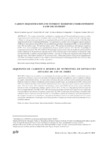Please use this identifier to cite or link to this item:
http://www.alice.cnptia.embrapa.br/alice/handle/doc/985494| Title: | Carbon sequestration and nutrient reserves under different land use systems. |
| Authors: | AGUIAR, M. I.  FIALHO, J. S.   CAMPANHA, M. M.   OLIVEIRA, T. S.   |
| Affiliation: | MONICA MATOSO CAMPANHA, CNPMS. |
| Date Issued: | 2014 |
| Citation: | Revista Árvore, Viçosa, MG, v. 38, n. 1, p. 81-93, 2014. |
| Description: | ABSTRACT-This study evaluated the contribution of agroforestry (AFS) and traditional systems to carbon sequestration and nutrient reserves in plants, litter and soil. The study was carried out in the semiarid region of Brazil in a long-term experiment on an experimental farm of the goat and sheep section of the Brazilian Agricultural Research Corporation (Embrapa). Two agroforestry systems were investigated: agrosilvopastoral (ASP) and forest-pasture areas (SP) as well as traditional agriculture management (TM), two areas left fallow after TM (six fallow years - F6 and nine fallow years - F9) and one area of preserved Caatinga vegetation (CAT). Soil, litter and plants were sampled from all areas and the contents of C, N, P, K, Ca and Mg per compartment determined. The AFS (ASP and SP) had higher nutrient stocks than the traditional and intermediate stocks compared to the preserved Caatinga. In the ASP, a relevant part of the nutrients extracted by crops is returned to the system by constant inputs of litter, weeding of herbaceous vegetation and cutting of the legume crops. After fallow periods of six and nine years, carbon and nutrient stocks in the compartments soil, litter and herbaceous plants were similar to those of the preserved Caatinga (CAT), but still lower than under natural conditions in the woody vegetation. RESUMO-Objetivou-se conhecer a contribuição de sistemas agroflorestais (SAFs) e tradicionais para o sequestro de carbono e a reserva de nutrientes presentes nas plantas, serrapilheira e solo. O estudo foi realizado na região semiárida brasileira, em experimento de longa duração realizado na Fazenda Experimental da Embrapa Caprinos e Ovinos. Estudaram-se dois sistemas agroflorestais: agrossilvipastoril (ASP) e silvipastoril (SP) e um tradicional (AG), sendo também utilizadas duas áreas sob pousio após o manejo tradicional (seis anos - F6 e nove anos F9) e uma área de Caatinga conservada (CAT). Nessas áreas, foram realizadas coletas de solo, serrapilheira e plantas, sendo os teores de C, N, P, K, Ca e Mg quantificados em cada um desses compartimentos. Os SAFs (ASP e SP) apresentaram estoques de nutrientes superiores ao tradicional e intermediários em relação à Caatinga conservada. No ASP, grande parte dos nutrientes extraídos pelas colheitas volta ao sistema por meio das entradas via serrapilheira, capinas das herbáceas e poda das leguminosas. Os estoques no solo, na serrapilheira e nas plantas herbáceas após os períodos de pousio de seis e nove anos foram semelhantes à Caatinga conservada, porém os estoques do estrato arbóreo foram inferiores à condição natural. |
| Thesagro: | Ecologia vegetal Agricultura familiar |
| NAL Thesaurus: | Agroecology Agroforestry |
| Keywords: | Agroecologia Sistema agroflorestal Family farming |
| Type of Material: | Artigo de periódico |
| Access: | openAccess |
| Appears in Collections: | Artigo em periódico indexado (CNPMS)  |
Files in This Item:
| File | Description | Size | Format | |
|---|---|---|---|---|
| Carbonsequestration.pdf | 350,43 kB | Adobe PDF |  View/Open |









